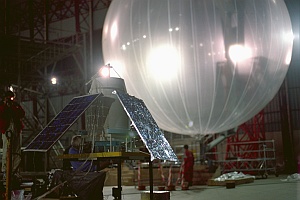This old base, established on 1929 -when the main airfield was built- have an outstanding history in aeronautics as the departure point for the first flights of the Military Air Mail.
It is located north of the city of Latacunga, and in more recent times has functioned as home base for the 12th Wing of the Air Force. Also in its facilities also operates the airport -named same as the base- that serves local flights. In 1985 was created there a number of facilities which together formed an important pole of the aviation industry. It constituted a key step towards achieving self-sufficiency in the work of maintaining military aircraft of the air force, and since 1989 also civil ones.
The use of the site for the launch of stratospheric balloons can be traced back to the early decade of 1990 when the French space agency CNES made two campaigns: the Pre-Amethyste (1991) and Amethyste (1994) during which were used MIR stratospheric balloons and superpressure ones in long duration flights. The choice of Cotopaxi base is directly related with the aim of the campaign: to study the transport of water vapor between the troposphere and the stratosphere in the equatorial regions. Lacatunga, located 1º south of the equator was the ideal site for the balloons which were caught by the air currents governed by the QBO (Quasi Biennial Oscillation) that characterizes the movement of air masses there.
A second objective was to analyze the performance of both types of balloons in areas of high convectivity. In this context, although there were some notable performances, most flights (especially regarding the MIR ones) finished their journey over the South-East of the Asian region due to poor conditions of thelluric infrared radiation due to the permanent presence of cloud formations in the area.
A subsequent campaign took place in 1998, exclusively with superpressure balloons to test various subsystems of such platforms. That was the last balloon campaign carried out there.
Recently, the Ecuadorian air force along with the National Secretariat of Science and Technology (SENACYT) and other academic and technical institutions, have initiated the development of a stratospheric platform or autonomous airship, which will carry out varied missions such as telecommunications, volcanic and geological research and border control. The development was carried out fairly in the hangars of Cotopaxi Air Force Base and was expected to be ready by 2010. However there is no information on the current status of the project.
Table of balloons launched from the Cotopaxi Air Force Base, Latacunga
| Date | Hour | Flight Duration | Experiment | Payload landing place or cause of the failure |
|---|---|---|---|---|
| 3/24/1991 | 7 d | ELHYSA (Etude de L'Hygromérie Stratosphérique) | --- No Data --- | |
| 4/3/1991 | 20 d | ELHYSA (Etude de L'Hygromérie Stratosphérique) | --- No Data --- | |
| 4/10/1991 | 42 d | ELHYSA (Etude de L'Hygromérie Stratosphérique) | Balloon lost over the Indian Ocean | |
| 1/14/1994 | 42 d | ELHYSA (Etude de L'Hygromérie Stratosphérique) | --- No Data --- | |
| 1/18/1994 | 7 d | ELHYSA (Etude de L'Hygromérie Stratosphérique) | --- No Data --- | |
| 1/23/1994 | 7 d | ELHYSA (Etude de L'Hygromérie Stratosphérique) | --- No Data --- | |
| 1/28/1994 | 6 d | ELHYSA (Etude de L'Hygromérie Stratosphérique) | --- No Data --- | |
| 2/3/1994 | 4 | 10 d | ELHYSA (Etude de L'Hygromérie Stratosphérique) | --- No Data --- |
| 3/28/1996 | 14 d | MIR SAMBA | --- No Data --- | |
| 4/5/1996 | 24 d | MIR SAMBA | --- No Data --- | |
| 8/25/1998 | 14.13.utc | 20.5 d | SAMBA | --- No Data --- |
| 9/1/1998 | 12.05 | 5 m | SAMBA | --- No Data --- |
| 9/1/1998 | 10.41 | 47 d | SAMBA | --- No Data --- |
| 9/4/1998 | 10.48 | 3 d | LMD1 | --- No Data --- |
| 9/7/1998 | 10.31 | 24 d | SAMBA | --- No Data --- |
| 9/11/1998 | 10.30 | 5 m | LMD2 | --- No Data --- |
If you consider this website interesting or useful, you can help me to keep it up and running with a small donation to cover the operational costs. Just the equivalent of the price of a cup of coffee helps a lot.



